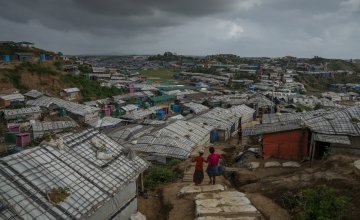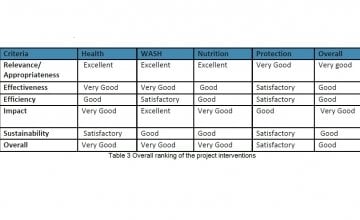
Read our 2023 annual report

Knowledge Hub
Integrated Emergency Humanitarian Response to the Rohingya Population in Cox's Bazar: Final evaluation 2018
The “Integrated Emergency Humanitarian Response to the Rohingya population in Cox’s Bazar” project is a joint collaboration of 5 agencies (Christian Aid Bangladesh (CAID), World Vision International (WVI), Concern Worldwide, Dhaka Ahsania Mission (DAM) and Gana Unnayan Kendra (GUK) through a consortium partnership with CAID as the lead to provide basic services and address the needs of the Rohingya community in selected camps. It was a 6-months project funded under the DFID Strengthening Humanitarian Preparedness and Response (SHPR) Programme in Bangladesh in 2018. This report is the final evaluation of that programme.
This report was commissioned to evaluate the impact and measure project achievements against the baseline of the project interventions which were focused on improving access to and utilization of quality WaSH, health, nutrition and protection services in selected six Rohingya camps. The report draws attention to the evaluation findings on four thematic areas of intervention – Health, WASH, Nutrition and Protection. Below findings of the evaluation are listed according to the themes.

The evaluation was conducted using the OECD-DAC criteria of relevance, effectiveness, efficiency, impact and sustainability. The evaluation divided the report into the sectors of health, WASH, nutrition and protection and then performed the analysis of each of these sectors using the OECD-DAC criteria.
The overall ranking on the five criteria was very good in the case of health, WASH and nutrition, whereas for protection is was satisfactory.

Key findings
Health
Relevance / Appropriateness: The evaluation found that all healthcare services provisioned were very welcome and well received by service providers and the community. The health centres were easily and frequently accessed by the community on a needs basis, and the need for healthcare services was pertinent, especially for the rainy season. 83% of respondents shared that there is easy access to the medical services in the camp, therefore it was considered as appropriately located by the evaluation. The availability of female doctors in the health centres in the first phase of the project was appropriate for the female members of the community, given the ease and comfort the have in discussing their gynaecological issues with the female doctor. Unfortunately in the second phase of the project, there was only one female doctor available which provided a challenge to cover the needs.
Despite the challenges, the evaluation found that the healthcare services provided under the project were relevant in the situational context of the camps.
Efficiency: The delay in disbursal of funds, approvals and staff recruitments delayed planned implementation timeline of the project activities. The assessment of documents and discussions with the project team and the beneficiaries revealed that the project implementation was to begin from September 2019 but it could only be initiated from December 2019. Despite these challenges, the DAM staff from the previous phase continued providing their services and continuum in the provisioning of services was kept. However, due to fund exhaustion, DAM had to reduce their activities conducted under the Health component of the project.
Effectiveness: Participants from focus group discussions shared that the ante-natal care (ANC) and post-natal care (PNC) services are effective and pregnant women were taken care of. It was also evident from the baseline and endline survey data that there had been an increase in the number of respondents receiving pregnancy/ maternal care in the medical centres in the camp with 81% at endline, compared to only 28% at baseline. The evaluation also showed increases from baseline to endline in accessing health information either door-to-door or through the health clinics, and in the provision of sexual and reproductive health (SRH) and family planning.
Impact: Overall, the evaluation team felt that the health services and counselling services being provided were appreciated by the community and that an immediate impact was observed in terms of community members being able to access medicines for short term illnesses and being provided immediate referral for serious illnesses. It was noted in the evaluation that more time was required to be able to assess the impact of counselling and family planning services.
Sustainability: Given the nature of the response, it was understood that sustainability would be a challenge. At the time of the evaluation there was no alternative plan in place in case bridge funding for continuing the project activities was not received.
WASH
Relevance / Appropriateness: The evaluation found that the toilets, gravity water points and bathing cubicles were the most important infrastructures built. The quality of toilets constructed was good and in line with the WASH sector guidelines. The provision of supports such as handles in the toilets were found to be useful for elderly and disabled people and pregnant women.
Efficiency and Effectiveness: The consortium under this project applied the consultative and methodical approach for the positive behaviour change for hygiene promotion through regular hygiene promotion training sessions. These sessions conducted by the project staff have been effective in bringing positive change in the awareness and attitude towards hygiene. Water point accessibility for the community was enhanced through deep tube wells and gravity water structures. Behaviour change in the community was systematically adopted and sustained through the formation of user groups which has ensured ownership and hygienic upkeep of the constructed toilets.
Impact: As a result of water availability, hygiene maintenance has enhanced within the community across four camps.
Sustainability: The toilets and gravity water points are essential and day to day utility structures, as a result, ownership amongst users have been developed successfully for proper upkeep of the structures. The user groups have been provided toilet cleaning kits and they use these kits for proper and hygienic upkeep of the toilets. Further rotation in the user group members is practised which ensures ownership is developed by all the users of that particular toilet. The community members expressed that the upkeep and maintenance of the toilet structure will be continued by them even after the completion of the project support stops, as it is their daily utility and they are the primary users. Although the user groups have developed ownership, this ownership trend is sporadic and it needs to replicate across the sites with localized strategies specific to the particular location and community members.
Nutrition
Relevance / Appropriateness: Given the fact that the food distributed in the camps only consists of rice, pulses and oil from the WFP food aid, the community members require dietary diversity in their food intake. Within the limited option, the community kitchen for the nutritional purpose was found to be appropriate and relevant. The community members are satisfied with the services and the women groups have appreciated the training and the door to door services. The OTP centre for the treatment of MAM and SAM children is also appropriate given the high percentage of malnourished children in the camps.
According to ISCG Joint Response Plan report (Jan- December) to the overall malnutrition rate is below the WHO emergency threshold of >15%, but within the serious category according to the SMART nutrition surveys conducted in April/May 2018. Lack of proper nutrition amongst the Rohingya community demands further scale up and improvement in the quality of nutrition services. Hence the team found that activities conducted under the nutrition component of the project was highly appropriate and needs to be continued.
Efficiency: The delay in the project initiation impacted the program efficiency. Since there was a delay in implementation of the project on the field, so it also delayed the process of getting seeds for the kitchen garden activity. As most of the vegetables are seasonal so this directly impacted the quality of the production achieved in the kitchen gardens of the community members (beneficiaries) from the distributed seeds. Distribution of seeds under the program activities has proved to be efficient as it served the family as well as help in getting extra income in case of surplus to the sustenance harvest.
Effectiveness: The baseline and the end line data shows that there has been an improvement in the nutrition services in the camp especially with the nutritional services for adolescent girls with improving from 47 % to 76%. During the FGD most of the respondents shared that the mother’s support group was effective and functional. The door to door visit by the volunteers has been very effective. However, the team found that the activities conducted with adolescent girls are not clear and the community members did not share any information on the same.
Impact and Sustainability: Despite the short duration of the programme, the substantial impact was visible with different mothers’ support groups functioning well and the dietary requirements of children under 5 being monitored. Groups were aware of essential topics on nutrition such as balanced diet, care required by young babies, care needed by lactating mother and pregnant women etc. SAM and MAM children are being identified and referred to outpatient therapeutic programmes (OTP) centres.
Protection
Relevance / Appropriateness: This was an important sector as many of the participants during the FGDs shared their need to have mechanism and awareness regarding protection issues. The members shared that there have been many trafficking cases in the camps and there is a need to raise the awareness level of the people. Hence addressing protection issues was an appropriate response. The female members of the community were highly satisfied with the dignity kits and felt it was much-needed item for them.
Efficiency and Effectiveness: During the FGDs the team felt that the training and awareness generation provided under the protection activity has been somewhat effective as the community members shared that they have a better awareness regarding issues of child marriages and GBV as and now they try their best to reduce the child marriage cases although the practice is still prevalent in the camp. The protection mechanism in the camps needs to be more effective. Most of the community members depend solely on Majhis for resolution of their problems and many do not consider raising it to the level of NGOs. Women in the FGD groups were not aware of the protection groups hence efforts are needed to strengthen this aspect. The involvement of male community members is needed for more effective programming and impact.
Although the majority of the respondents in the endline survey reported that they were aware of the existing mechanism for registering or recording a complaint, the majority of respondents mentioned that it is effective only to some extent. A small positive change in perception about the action taken by authorities following complaints was noted.
Impact and Sustainability: Although it was a short project, the evaluation team felt that there had been an increase in awareness on issues such as trafficking, early marriage and gender-based violence. However, the evaluation noted that most of the protection activities involved training and awareness generation, which take time for the results to appear.
The full evaluation report, including a description of the methodology employed and recommendations can be viewed in the report below:
This document covers humanitarian aid activities implemented with the financial assistance of the UK's Department for International Development, DFID [now replaced by the Foreign, Commonwealth and Development Office (FCDO)]. The views expressed herein should not be taken, in any way, to reflect the official opinion of the FCDO, and the FCDO is responsible for any use that may be made of the information it contains.

